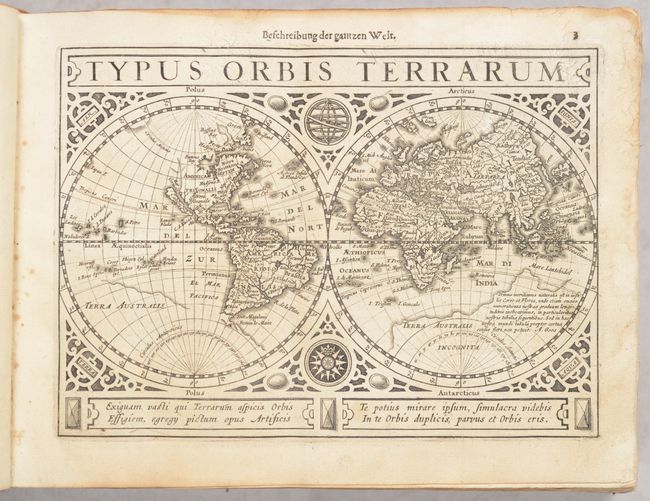Subject: Atlases
Period: 1631 (published)
Publication:
Color: Black & White
Size:
9.5 x 7.4 inches
24.1 x 18.8 cm
Mercator's Atlas Minor was conceived by Jodocus Hondius in 1607 as a reduced-sized edition of the popular folio-sized Mercator Atlas. The Atlas Minor was intended to be larger than a pocket atlas, yet smaller than the folio atlas, and were priced accordingly to reach a new market. There were three different editions of the Atlas Minor published by different authors, each with a new set of copperplates. Hondius published the first edition from 1607-1621, and subsequently sold the copperplates to parties in England between 1621-1625, after which an English edition was published using many of the original plates in 1635-39. Johannes Jansson wanted to compete in the small atlas market as well, and had new copperplates engraved by Pieter van den Keere and Abraham Goos for his own edition published in multiple languages between 1628-51. The third and final edition was published by Jan Evertsz. Cloppenburch (or Cloppenburg) between 1630-1734 (some without text), with new maps engraved primarily by Pieter van den Keere.
This example is the first German edition of Jansson's Atlas Minor, published in 1631 with 143 maps. Included are maps of the world, continents, north pole, and regional maps of Europe (117), Africa (5), Asia (10), North America (3), and South America (2). Some of the more interesting maps include:
A. Typus Orbis Terrarum is a beautiful double hemisphere world map surrounded in strapwork borders into which are set an armillary sphere and a compass rose. The map features the island of California with no coastline continuing to the northwest. Terra Australis has a broken coastline and a notation that ends with the signature of the engraver, A. Goos. Four lines of Latin text balance the title cartouche at bottom. Reference: Shirley #325.
B. The most dominant feature of Americae Descriptio is the curious depiction of the west coast of North America, which is completely bisected by an unnamed strait hinting at a Northwest Passage. The bulging northwest coast of North America continues another 65 degrees and is separated from Asia by a narrow Fretum Anian and California is shown as a peninsula. These features were derived from the Van den Keere and Plancius globe of 1614 and this is the first time they appear on a map of the Americas. Previous maps had depicted the supposed Northwest Passage through the Strait of Anian. Other interesting features include the St. Lawrence River flowing from a small lake in the west, no Great Lakes, and an area of shading in Virginia alluding to the possibility of a Verrazano-type inland sea. In the southern hemisphere, two large mythical lakes appear in South America, Tierra del Fuego is only partially delineated, and there is a massive southern continent (Terra Australis Incognita). Reference: Burden #221.
C. Nova Virginiae Tabula is a reduced version of John Smith's map of the Chesapeake Bay region. Although it is the second derivative of Smith's map, it is actually the first derivative published in an atlas. Despite its small size, it is filled with towns with both English and Native names, including Jamestown (Iamestowne), and a key to the types of buildings on the left and pictorial topography. Engraved by Pieter van den Keere with his Latinized name appearing below the title cartouche. This map was a new addition for Jan Jansson's editions of the Atlas Minor, and was not included in Hondius' editions. References: Burden #223; Wooldridge #33.
D. The map of the North Pole, Septentrionalium Terrarum Descript., does not follow Mercator, but used the knowledge of the many recent exploratory voyages that attempted to locate a northern route to Asia. Several fictitious islands, including Frisland, appear in the North Atlantic.
Oblong Octavo; 600 pages plus title page, preface and index. Rebacked with contemporary spine strip preserved and contemporary boards. All edges gilt.
References: Koeman, Me #199; Shirley (BL Atlases) T.Jan 14a.
Condition: B
The maps have good impressions and range from good to very good with some light toning, dampstaining and minor soiling. The first third of the volume, including the world and continent maps, is very good while the latter two-thirds is good with more pronounced toning and dampstaining around the gutter. The world map has some minor abrasions along the top border and there are a few small stains in the continent maps (all B+). The map of Brescia has a couple of archivally repaired tears at top and a related small surface abrasion (B). Text is in similar condition to the maps, and there is a small tear to page 183 at bottom. Ex-library with bookplate on the front pastedown and a couple of stamps in the text and in the margin of the map of China. Covers are heavily soiled and worn. Spine has been rebacked.














